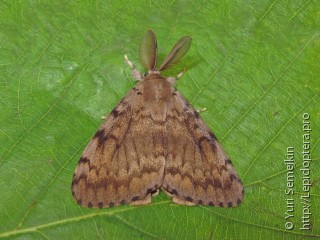Lymantria dispar
Taxonomy
class Insecta
Species name(s)
Lymantria dispar (Linnaeus, 1758) = Phalaena dispar Linnaeus, 1758 = Lymantria dispar asiatica Wnukowsky, 1926 = Lymantria dispar albescens Matsumura, 1927 = Lymantria dispar praeterea Kardakoff, 1928 = Lymantria dispar andalusiaca Reinig, 1938 = Lymantria dispar mediterranea Goldschmidt, 1940 = Lymantria dispar bocharae Goldschmidt, 1940 = Lymantria dispar chosenensis Goldschmidt, 1940 = Lymantria dispar koreibia Bryk, 1948 = Lymantria dispar kolthoffi Bryk, 1948 = Liparis japonica. [9, 10]
Gypsy Moth.
urn:lsid:insecta.pro:taxonomy:6949
Expansion
This species marks on the maps: 7.
Zoogeographical regions
Palaearctic, Nearctic.
Russia regions
#1. Kaliningradsky; #4. Evropeisky Severo-Zapadny; #6. Evropeisky Severo-Vostochny; #7. Evropeisky yuzhno-tayozhny; #8. Evropeisky Tsentralny; #9. Evropeisky Tsentralno-Chernozyomny; #10. Sredne-Volzhsky; #11. Volgo-Donsky; #12. Nizhnevolzhsky; #13. Zapadno-Kavkazsky; #14. Vostochno-Kavkazsky; #16. Sredne-Uralsky; #17. Yuzhno-Uralsky; #19. Sredneobsky; #20. Yuzhno-Zapadnosibirsky; #22. Krasnoyarsky; #23. Predaltaisky; #24. Gorno-Altaisky; #25. Tuvinsky; #26. Predbaikalsky; #27. Pribaikalsky; #28. Zabaikalsky; #36. Sredne-Amursky; #37. Nizhne-Amursky; #38. Sakhalin; #39. Yuzhno-Kurilsky; #40. Primorsky.
Forewing length
25—32 mm.
Wingspan
40—90 mm.
Primary colors
Brown/Gray/Black, White.
Flight time
| January | February | March | April | May | June | July | August | September | October | November | December |
Larva lifespan
| January | February | March | April | May | June | July | August | September | October | November | December |
Over-wintering stage
Ova.
Detailed information with references
Taxonomy, synonyms and combinations
Distribution
Imago Habitus and Differences from alike species
General info about Imago
Imago lifespan
Larva food plants / other food objects
Larva lifespan
Overwintering stage
Subspecies of Lymantria dispar
- Lymantria dispar dispar (Linaeus, 1758). [10]
- L. d. hokkaidoensis Goldschmidt, 1940. [9]
- L. d. japonica (Motschulsky, 1860). [9]
- L. d. obscura Goldschmidt, 1940. [9]
- L. d. postalba Inoue, 1956. [9]
- L. d. tsushimensis Inoue, 1956. [9]
Authors
Initial species uploading to the site: Peter Khramov.
Text data: Peter Khramov, Vasiliy Feoktistov, Yuri Semejkin.
The species characteristics formalization: Peter Khramov, Vasiliy Feoktistov.
References
- [1] O. Karsholt, J. Razowski (eds.), 1996. The Lepidoptera of Europe: a distributional checklist
- [3] Каталог чешуекрылых (Lepidoptera) России. Под ред. С. Ю. Синёва. СПб.; М.: Товарищество научных изданий КМК, 2008
- [5] Райххолф-Рим Х. Бабочки. М.: Астрель, 2002
- [9] Tree of Life (funet.fi), 2012
- [10] de Jong, Y.S.D.M. (ed.) (2011) Fauna Europaea version 2.4 (faunaeur.org)
- [61] Новак В., Грозинка Ф., Стары Б. Атлас насекомых-вредителей лесных пород. Прага: Государственное сельскохозяйственное издательство, 1974
- [PC93] Vasiliy Feoktistov
- [PC238] Yuri Semejkin
Comments
Note: you should have a Insecta.pro account to upload new topics and comments. Please, create an account or log in to add comments
Lymantria dispar photos





















































































All the photos of the species in large size
Please, create an account or log in to upload your photo














